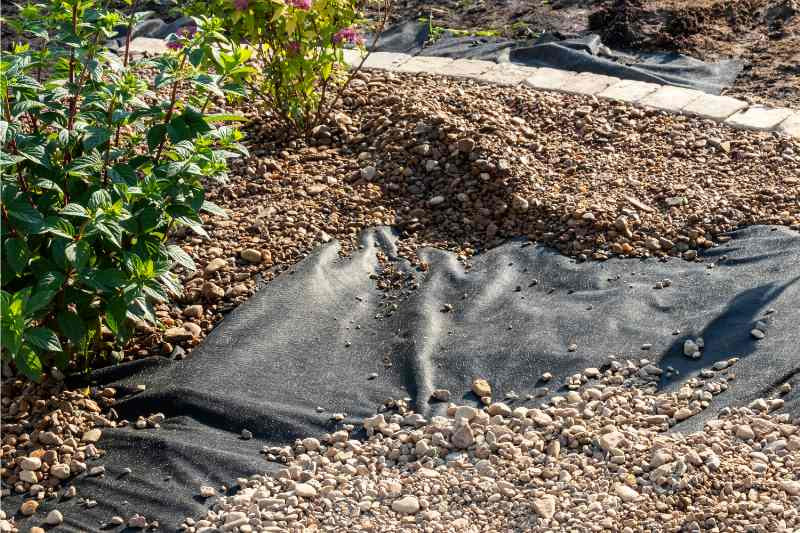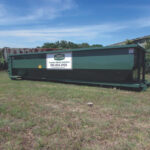Are you looking to install landscape fabric under rocks to create a stunning, weed-free rockscape? At rockscapes.net, we understand the importance of a well-maintained landscape. This comprehensive guide will walk you through the process of installing landscape fabric beneath rocks, ensuring a beautiful and durable outdoor space. Discover how to choose the right materials and techniques for effective weed control, soil stabilization, and long-lasting aesthetic appeal.
1. What Is Landscape Fabric and Why Use It Under Rocks?
Landscape fabric, also known as weed barrier fabric or weed control fabric, is a geotextile material designed to prevent weed growth while allowing water and nutrients to permeate the soil. Using landscape fabric under rocks provides several benefits for any landscaping project:
- Weed Prevention: Landscape fabric acts as a physical barrier, preventing weeds from sprouting and growing through your decorative rocks.
- Soil Stabilization: It helps to stabilize the soil, preventing erosion and maintaining the integrity of your landscape design.
- Moisture Retention: Landscape fabric can help retain moisture in the soil, reducing the need for frequent watering.
- Separation: It prevents the rocks from sinking into the soil, keeping your landscape looking clean and defined.
2. Who Benefits from Installing Landscape Fabric Under Rocks?
Landscape fabric is a versatile solution for various individuals and projects. Here’s how it can benefit different groups:
- Homeowners: Those looking to enhance their yards with rock gardens, pathways, or decorative rock beds can use landscape fabric to minimize maintenance and keep their landscapes looking pristine.
- Landscape Designers and Architects: Professionals can incorporate landscape fabric into their designs to ensure the longevity and beauty of their rock-based landscapes.
- Gardeners and Plant Enthusiasts: Using landscape fabric around rock features can help create a low-maintenance environment that supports healthy plant growth.
- DIY Enthusiasts: Anyone tackling outdoor projects can use landscape fabric to achieve professional results with minimal effort.
- Suppliers and Businesses: Understanding the benefits and applications of landscape fabric can help businesses better serve their customers with high-quality landscaping materials.
3. What Are the Different Types of Landscape Fabric?
Selecting the right type of landscape fabric is essential for the success of your project. Here are the main types, each with unique characteristics:
- Woven Landscape Fabric: Made from woven linen or polypropylene fibers, it allows water and air to pass through small holes. Ideal for areas with established plants, such as trees, shrubs, and flower beds.
- Durability: Resistant to punctures and tears but less durable than spun or non-woven options.
- Non-Woven Landscape Fabric: A solid sheet of material, typically made from polypropylene or polyester, offering good weed control. Best for use under rock ground covers and pathways.
- Durability: Excellent for rock landscapes but may restrict water and air flow in planted areas.
- Spun Landscape Fabric: A type of non-woven fabric made from long polyester fibers bonded together. Highly durable and suitable for use under gravel pathways and rock gardens.
- Durability: Can also be used behind retaining walls to prevent plant roots and soil seepage.
- Perforated Landscape Fabric: A solid sheet with small, perforated holes for easy water and air passage. Lightweight and best suited for vegetable gardens or flower beds where frequent digging is required.
- Durability: Not recommended for use under gravel due to its poor weed barrier properties.
4. What Tools and Materials Do You Need to Install Landscape Fabric Under Rocks?
Having the right tools and materials on hand will make the installation process smoother and more efficient. Here’s a comprehensive list:
| Tool/Material | Description |
|---|---|
| Garden Hoe | Used for removing weeds and preparing the soil surface. |
| Hand Tamper | Helps to compact and level the soil, especially for pathways. |
| Tape Measure | Essential for accurately measuring the area to be covered. |
| Rubber Mallet/Hammer | Used for securing garden staples into the ground. |
| Utility Knife | For cutting the landscape fabric to the desired size and shape. |
| Scissors | An alternative for cutting fabric, useful for more delicate adjustments. |
| Garden Gloves | Protects hands during the installation process. |
| Landscape Staples | Secures the fabric to the ground, preventing it from shifting or blowing away. |
| Bow Rake | For smoothing and leveling the soil and spreading rock mulch. |
| Digging Shovel/Trowel | For planting and moving soil as needed. |
| Plants (Optional) | If incorporating plants into the rock landscape, select appropriate species. |
| Rock Mulch | Your choice of rocks, such as river rock or pea gravel, for the top layer. |
| Landscape Fabric | The weed barrier fabric itself; choose the appropriate type for your project. |
| Herbicide (Optional) | For pre-treating the area to kill existing weeds before installing the fabric. |
5. Step-by-Step Guide: How To Install Landscape Fabric Under Rocks
Installing landscape fabric under rocks is a straightforward process that can be completed in a few simple steps. Follow this guide to achieve the best results:
5.1. Step 1: Measure the Area
- Accurately measure the area you plan to cover with rocks to determine the amount of landscape fabric needed.
- Consider buying extra fabric to account for mistakes, overlaps, and edges. For example, if the area is 20 square feet, purchase at least 25 square feet of fabric.
5.2. Step 2: Remove Existing Weeds
- Clear the area of all existing weeds. Pull them by hand or use a garden hoe to cut their roots.
- Consider applying a weed killer and waiting at least two weeks before laying the fabric.
5.3. Step 3: Clear Debris
- Use a garden rake to remove any remaining debris, such as leaves, twigs, and stones.
- Ensure the area is clean and free of any materials that could interfere with the fabric’s performance.
5.4. Step 4: Level the Soil Surface
- Use a garden rake to spread the soil evenly, creating a flat surface.
- For pathways, use a hand tamper to compact the soil, providing a stable base for the rocks. According to research from Arizona State University’s School of Earth and Space Exploration, compacted soil provides a more stable base for landscape features.
5.5. Step 5: Add Soil Amendments (Optional)
- If planting in the area, now is the time to add soil amendments like compost to enrich the soil.
- This step is unnecessary for gravel pathways or rock ground covers without plants.
5.6. Step 6: Roll Out the First Sheet of Fabric
- Start at one end of the area and roll out the landscape fabric. Have someone hold the material taut to prevent wrinkles.
- Ensure the correct side of the fabric faces down (usually the fuzzy side).
- Extend the fabric a few inches past the edges of the area.
5.7. Step 7: How to Handle Existing Plants
- When encountering an existing plant, you have two options:
- Slit Method: Cut a slit from the fabric’s edge to the plant. Slide the plant through the slit and continue rolling out the fabric.
- X-Incision Method: Cut an X-shaped incision where the plant will grow. Fold back the flaps, drape the fabric over the plant, and pull the plant through the incision.
- Regularly check young plants to ensure the fabric hole isn’t girdling the stem or trunk.
5.8. Step 8: Roll Out Remaining Sheets and Overlap
- Overlap each piece of landscape fabric by 6 to 12 inches to prevent weeds from growing through the gaps.
- This overlap ensures a continuous barrier against weed growth.
5.9. Step 9: Secure the Fabric
- Use garden staples to secure the fabric to the ground.
- Place staples every foot along the edges, around slits and X-shaped incisions, and along overlaps.
- Add staples every square foot within the interior area for maximum security.
5.10. Step 10: Install Edging (Optional)
- If your design includes edging, install it now.
- Wrap the excess landscape fabric underneath the edging to prevent weeds from growing between the stones and edging.
5.11. Step 11: Spread the Stones
- Spread the rock mulch evenly over the landscape fabric.
- Ensure the fabric is completely covered, with a rock layer no more than 2 inches thick.
 Gravel over landscape fabric
Gravel over landscape fabric
6. Benefits of Using Landscape Fabric
Landscape fabric provides numerous benefits for maintaining a beautiful and functional landscape:
- Prevents Gravel from Sinking: It creates a barrier that stops rocks from sinking into the soil over time.
- Easier Gravel Removal: Facilitates easy removal of stones when needed, without the hassle of digging them out of the soil.
- Effective Weed Prevention: Prevents weeds from growing between the rocks, maintaining the aesthetic appeal of the landscape.
7. What Are the Potential Drawbacks of Using Landscape Fabric?
While landscape fabric offers many advantages, it’s essential to be aware of its potential drawbacks:
- Not 100% Weed-Proof: Weeds may still grow on top of the fabric if seeds are blown in.
- Clogging Over Time: The fabric can clog with soil particles, reducing water and air flow.
- Root Entanglement: Plant roots may grow into the fabric, making removal difficult.
- Earthworm Suffocation: It can suffocate earthworms, which are beneficial for soil health.
- Prevents Organic Mulch Improvement: It prevents organic mulches from improving the soil.
8. Cost Considerations for Installing Landscape Fabric Under Rocks
Understanding the costs involved can help you budget effectively for your landscaping project:
- Landscape Fabric: Typically costs $0.45 – $0.80 per square foot.
- River Rocks: Range from $60 – $170 per ton.
- Pea Gravel: Costs between $0.86 and $3.78 per square foot.
9. Alternatives to Landscape Fabric
If landscape fabric isn’t the right choice for your project, consider these alternatives:
- Cardboard: An eco-friendly option that decomposes over time, enriching the soil.
- Pine Needles: A natural mulch that helps suppress weeds and retain moisture.
- Burlap: A biodegradable fabric that provides a barrier against weeds.
10. Addressing Common Challenges and FAQs
10.1. Common Challenges
- Poor Water Permeability: Ensure you select a landscape fabric with adequate permeability for your plants.
- Weed Growth on Top: Regularly remove any weeds that sprout on top of the fabric.
- Fabric Degradation: Replace the fabric as needed, typically every few years, to maintain its effectiveness.
10.2. FAQs About Landscape Fabric
- Is landscape fabric permanent? No, it’s not a permanent solution and needs replacement over time.
- What are the disadvantages of using landscape fabric? It can clog, harm plant health, and prevent organic mulch from improving the soil.
- If I want to install landscape fabric and new plants, which should I do first? Lay the fabric before planting to make the process easier.
11. Need Professional Help?
Installing landscape fabric can be a DIY project, but if you prefer professional assistance, consider hiring a local lawn care service. A professional can help you choose the best weed barrier, prepare the landscape bed, lay the fabric, and spread the rocks.
12. Why Choose rockscapes.net for Your Landscaping Needs?
At rockscapes.net, we provide a wide range of resources to help you create the perfect rockscape. From selecting the right type of rock to offering expert advice on installation techniques, we are your go-to source for all things landscaping. We offer comprehensive guides, detailed product information, and personalized support to ensure your project is a success. Visit our website at rockscapes.net or contact us at +1 (480) 965-9011 for more information. Our address is 1151 S Forest Ave, Tempe, AZ 85281, United States.
13. How Can rockscapes.net Help You Further?
- Inspiration: Explore our extensive gallery of rock landscape designs for inspiration.
- Expert Advice: Access articles and guides on various landscaping topics.
- Product Information: Get detailed information on different types of rocks and landscaping materials.
- Professional Consultation: Connect with our experts for personalized advice and support.
14. Conclusion
Installing landscape fabric under rocks is a simple yet effective way to enhance the beauty and longevity of your landscape. By following this guide and considering the various factors involved, you can create a stunning, low-maintenance outdoor space that you’ll enjoy for years to come.
15. Call to Action
Ready to transform your landscape? Visit rockscapes.net today to explore our wide selection of rocks and landscaping materials. Get inspired by our design ideas, learn from our expert guides, and take the first step towards creating the rockscape of your dreams. Contact us now and let us help you bring your vision to life.
FAQ: Frequently Asked Questions
1. What is the primary purpose of landscape fabric?
The primary purpose of landscape fabric is to prevent weed growth while allowing water and nutrients to permeate the soil, enhancing the health and appearance of your landscape.
2. What types of landscape fabric are best for under rocks?
Non-woven and spun landscape fabrics are generally considered the best options for under rocks due to their durability and effectiveness in weed prevention.
3. How do I prepare the area before installing landscape fabric?
Before installing landscape fabric, remove all existing weeds, clear debris, and level the soil surface to create a clean and even base.
4. How much overlap is needed when installing multiple pieces of landscape fabric?
A 6- to 12-inch overlap between each piece of landscape fabric is recommended to prevent weeds from growing through the gaps.
5. How do I secure landscape fabric to the ground?
Landscape staples should be used every foot along the edges, around slits and X-shaped incisions, and along overlaps, as well as every square foot within the interior area.
6. What are the disadvantages of using landscape fabric in my garden?
Disadvantages include the potential for clogging, harm to plant health if roots grow into the fabric, and prevention of organic mulch from improving the soil.
7. Can I use landscape fabric in vegetable gardens?
Perforated landscape fabric is suitable for vegetable gardens as it allows easy passage of water and air and is lightweight for frequent digging.
8. What are some alternatives to using landscape fabric?
Alternatives include cardboard, pine needles, and burlap, which are biodegradable and offer weed control benefits.
9. How often should landscape fabric be replaced?
Landscape fabric should be replaced as needed, typically every few years, to maintain its effectiveness.
10. Where can I find high-quality landscape fabric and rocks for my project?
Visit rockscapes.net for a wide selection of high-quality landscape fabric, rocks, and expert advice for your landscaping project, or contact us at +1 (480) 965-9011.
This comprehensive guide equips you with the knowledge to install landscape fabric under rocks effectively, ensuring a beautiful and long-lasting landscape.

